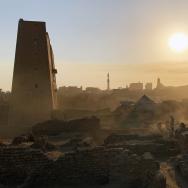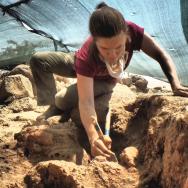The lion and the bull have been fighting, locked in stone, for nearly 2,500 years—ever since an ancient sculptor carved them into a slab of black limestone and set them into a monumental staircase at Persepolis, the royal center of the great Achaemenid Empire.
The two animals were meant to reflect the prestige of this vast Persian empire, which fell in 330 B.C. when Alexander the Great sacked and burned Persepolis and its opulent palaces. The giant stone relief remained there among the ruins until 1931, when the University of Chicago’s Oriental Institute began a landmark excavation of the site—and gave the lion and bull a second life.
For the past 80 years, the 4,000-pound stone relief was on loan to the Boston Museum of Fine Arts. But it has returned to the University of Chicago in honor of the OI’s 100th anniversary as one of the world’s foremost research centers on the civilizations of the ancient Middle East. The rare artifact is available for public viewing at the Oriental Institute Museum starting on September 28th, when the OI will host a public celebration—the first in a yearlong series of centennial events open to the University community and the general public.
“We are thrilled to have this magnificent relief back in Chicago to help celebrate the OI’s century of transformative research on the ancient Middle East,” said Christopher Woods, director of the OI and the John A. Wilson Professor of Sumerology. “The beauty and majesty of the relief just leaps out at you.”
The relief dates to about the fourth century B.C., when Persepolis stood as the ceremonial center of the Achaemenid Empire, which spanned much of the ancient Middle East.
“Looking at this monumental imagery gives you insights into the imperial ideology—how the Achaemenid kings conceived of themselves and the identity they wanted to project,” said Woods, a leading scholar of Sumerian language and writing.
“The image of a lion and bull in combat has a long tradition in the ancient Middle East, stretching back thousands of years,” said Jean M. Evans, chief curator and deputy director of the OI Museum. “In the relief, these noble and powerful animals are marshalled to reflect the power and prestige of the empire.”

Rising to power in approximately 550 B.C., the Achaemenid Empire was the largest empire the world had known; its extensive central administration set the model for later empires and is an essential piece of understanding the journey of human civilization. But after just two centuries, Persepolis—and the empire—fell when Alexander the Great’s armies sacked the city in 330 B.C.
According to Roman historian Plutarch, it took 20,000 mules and 5,000 camels to carry away the treasure Alexander’s army looted from Persepolis. Left behind, however, were columns and halls, staircases and gates—all finely carved by the craftsmen of the Achaemenid royal court.
Many of these were still standing two millennia later, when the OI began a pioneering excavation that spanned eight years and required hundreds of workmen. Over the multi-acre site, the excavation uncovered everything from the kings’ cups and bowls to the treasures looted during the Achaemenid conquests of other kingdoms.
“The beauty and majesty of the relief just leaps out at you.”
Hundreds of cuneiform tablets, preserved by their baking in the fires that consumed the rest of the city, filled out the details of life in ancient Persepolis. From them, scholars learned everything from land deals and taxes to how much haoma, the sacred intoxicating drink, should be used during religious services.
While much of what was excavated remains on site at Persepolis, several large pieces, such as the head of a colossal bull that once guarded the Hundred-Columned Hall, in addition to smaller finds, were given to the OI by Iranian authorities in recognition of the work that went into uncovering and preserving the ancient site and were shipped to Chicago, where they have been on display at the OI Museum for nearly a century. The relief of a lion and bull in combat, however, went on long-term loan to Boston Museum of Fine Arts.
In honor of the OI’s centennial, the Museum made plans to bring the stone relief back to Chicago.

Moving such a rare and precious piece of art is a massive undertaking. At the Boston Museum of Fine Arts, Laura D’Alessandro, head of the conservation laboratory at the OI, oversaw the creation of the custom crate in which the relief would travel. The relief was carefully supported with inert foam blocks at critical pressure points within the crate for its thousand-mile journey by climate-controlled truck to Chicago.
Once at the OI, the relief was allowed to acclimate to the new environment as a space was prepared for it in the museum. It was then meticulously cleaned by conservation staff in preparation for its display in the galleries. In August, D’Alessandro watched as the piece was wrapped in a special inert fabric that would not interact with or damage the stone, shrink-wrapped and then covered in several layers of quilted blankets. The wrapped stone was then secured to the base of the crate in preparation for the very slow move—by pallet truck and elevator—and then carefully rigged into position in its new home in the Persian Gallery.
“It’s a really beautiful piece, in excellent condition, and we’re very happy to see it reunited with the Persepolis artifacts in the gallery,” D’Alessandro said.
Visitors can see the relief in the Robert and Deborah Aliber Persian Gallery, alongside a colossal stone bull head, column capitals, and other artifacts from the Persepolis excavations.
“It’s a really beautiful piece...we’re very happy to see it reunited with the Persepolis artifacts in the gallery.”
“This is an opportunity to look back over our long, illustrious history of excavation and research on the ancient Middle East, but at the same time it’s a unique opportunity to look to the future and our goals for the next century,” Woods said.
Other new exhibits for the OI centennial, as well as a full listing of events, can be found at the OI’s centennial website.











